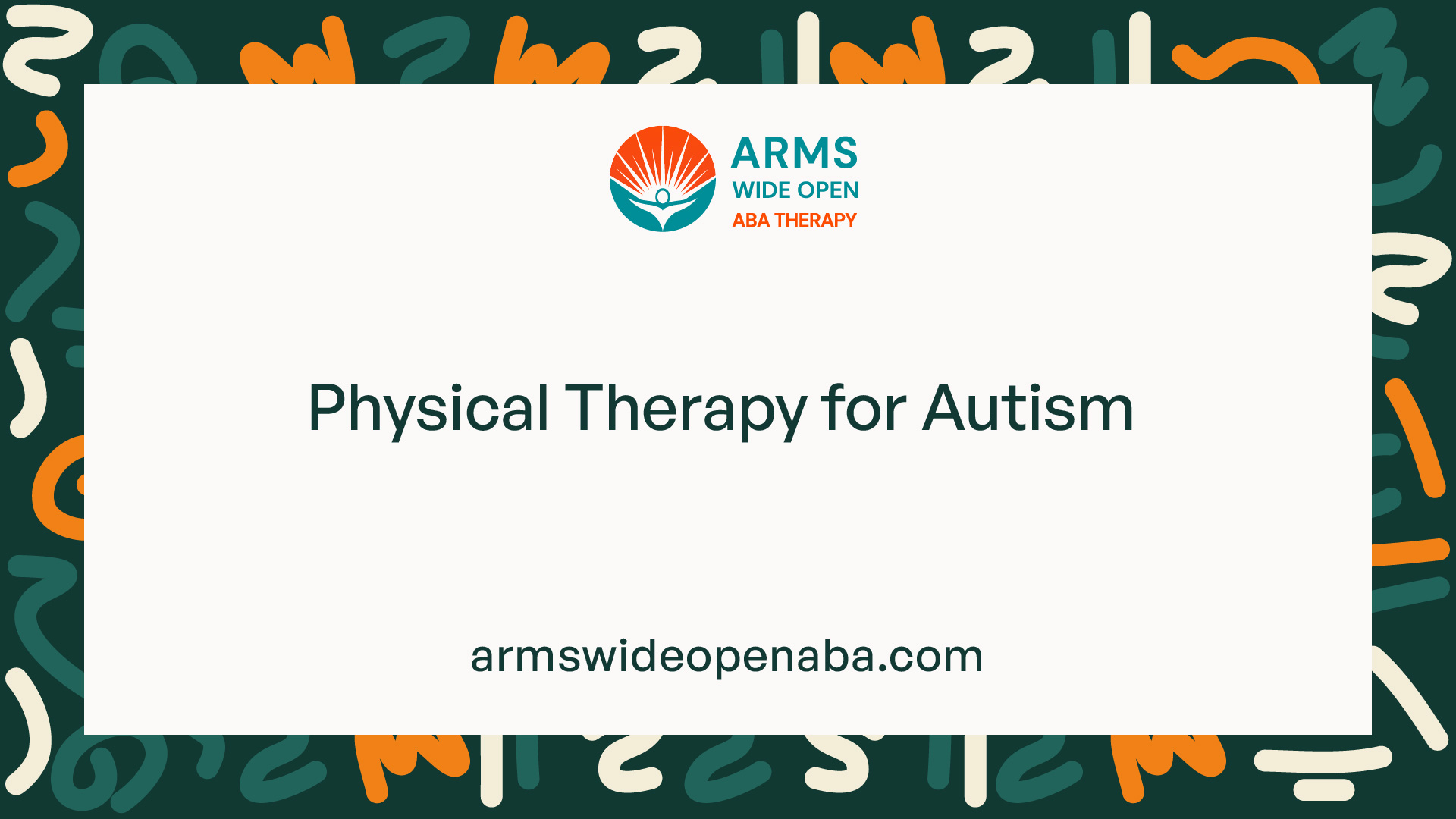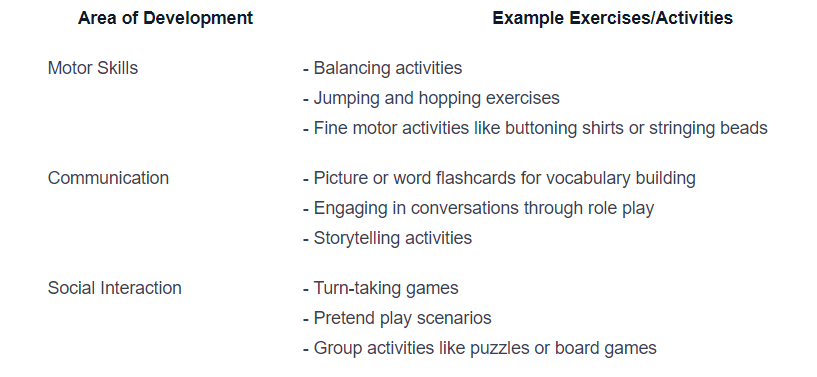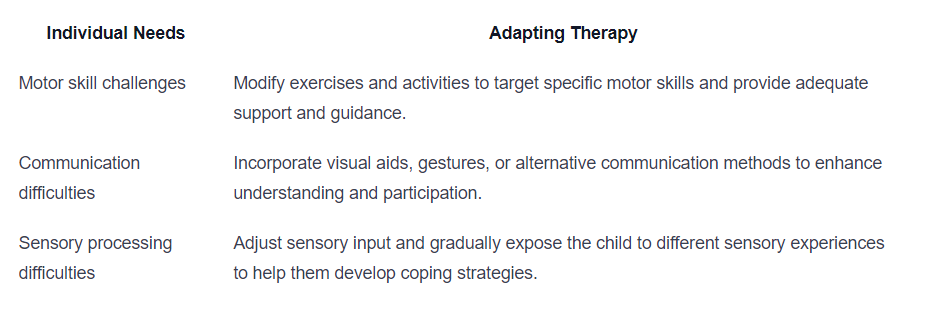Physical Therapy for Autism
Unlock the potential with physical therapy for autism. Improve motor skills, communication, and social interaction. Find out more!

Understanding Autism and Physical Therapy
In order to fully comprehend the benefits of physical therapy for individuals with autism, it is important to have a clear understanding of autism itself and the role that physical therapy plays in its treatment.

Overview of Autism
Autism, also known as Autism Spectrum Disorder (ASD), is a developmental disorder that affects individuals in various ways. It is characterized by challenges in social interaction, communication difficulties, and repetitive behaviors or restricted interests. Autism is a spectrum disorder, meaning that it encompasses a wide range of symptoms and abilities. Each individual with autism is unique, with their own strengths and challenges.
Role of Physical Therapy in Autism Treatment
Physical therapy is a crucial component of the multidisciplinary approach to treating autism. While it does not directly target the core symptoms of autism, such as social and communication difficulties, physical therapy focuses on improving motor skills, coordination, and overall physical well-being. By addressing these areas, physical therapy can enhance the overall quality of life and functioning of individuals with autism.
Physical therapists who specialize in working with individuals on the autism spectrum use evidence-based techniques to help improve motor skills, balance, strength, and coordination. They tailor their interventions to the specific needs of each individual, taking into consideration their unique abilities and challenges.
Through engaging in physical therapy, individuals with autism can experience a range of benefits that positively impact their daily lives. These benefits extend beyond the physical realm and can have a positive impact on communication skills, social interaction, and overall self-confidence.
To fully understand the benefits of physical therapy for autism, it is important to explore the specific areas in which it can make a difference. The following sections will delve into the various benefits of physical therapy for individuals with autism, as well as the different approaches used in physical therapy interventions.
Benefits of Physical Therapy for Autism
Physical therapy plays a vital role in the treatment of individuals with autism, offering a range of benefits that can greatly enhance their overall well-being. Let's explore three key benefits of physical therapy for individuals with autism: improved motor skills, enhanced communication skills, and promoted social interaction.
Improved Motor Skills
Physical therapy interventions are designed to target and improve motor skills in individuals with autism. Motor skills encompass both gross motor skills, involving larger muscle groups and coordination, as well as fine motor skills, involving smaller muscle groups and dexterity.
Through a variety of exercises, activities, and interventions, physical therapists work to enhance motor skills such as balance, coordination, strength, and body awareness. These improvements in motor skills can have a positive impact on an individual's ability to perform daily activities, participate in sports or recreational activities, and navigate their environment with greater ease.
Enhancing Communication Skills
Communication challenges are common among individuals with autism, and physical therapy can contribute to enhancing their communication skills. Physical therapists use various strategies and techniques to promote communication, such as incorporating sign language or visual aids during therapy sessions.
By engaging in activities that require communication, such as following instructions or expressing needs and preferences, individuals with autism can develop and refine their communication skills. Physical therapy can also help improve verbal skills, articulation, and speech fluency, enabling individuals to better express themselves and interact with others.
Promoting Social Interaction
Social interaction can be a significant challenge for individuals with autism, but physical therapy can play a valuable role in promoting social skills and interaction. Through group activities and structured play, physical therapists create opportunities for individuals with autism to engage with peers and practice social skills in a supportive environment.
Physical therapy sessions may include cooperative games, turn-taking activities, and partner exercises, which encourage social interaction and cooperation. By participating in these activities, individuals with autism can develop important social skills, such as sharing, taking turns, and understanding nonverbal cues, that can enhance their ability to interact and connect with others.
By focusing on improving motor skills, enhancing communication skills, and promoting social interaction, physical therapy offers valuable benefits for individuals with autism. These benefits can greatly contribute to their overall development, independence, and quality of life.
Types of Physical Therapy Approaches
Physical therapy plays a crucial role in the comprehensive treatment of individuals with autism. There are several different approaches to physical therapy that are commonly used to address the unique needs of individuals on the autism spectrum. These approaches include sensory integration therapy, applied behavior analysis (ABA) therapy, and occupational therapy.
Sensory Integration Therapy
Sensory integration therapy focuses on addressing sensory processing difficulties commonly experienced by individuals with autism. The goal of this therapy is to help individuals better understand and respond to sensory information from their environment. By engaging in activities that stimulate the senses, such as swinging, jumping, or deep pressure touch, sensory integration therapy aims to improve sensory processing, coordination, and self-regulation.
Sensory integration therapy is often conducted by trained occupational therapists who work closely with individuals to create a personalized treatment plan. The therapy sessions may involve a range of activities designed to provide sensory input and promote adaptive responses. These activities can help individuals with autism develop better body awareness, motor planning skills, and sensory modulation abilities.
Applied Behavior Analysis (ABA) Therapy
Applied Behavior Analysis (ABA) is a behavioral therapy approach widely used in the treatment of autism. While ABA therapy primarily focuses on behavior modification, it can also incorporate physical therapy components. ABA therapists work with individuals to develop and reinforce positive behaviors while minimizing challenging behaviors. Physical therapy within ABA may involve exercises and activities that target motor skills, coordination, and physical development.
ABA therapy typically follows a structured and individualized approach, with therapists using behavior analysis techniques to assess, monitor, and modify behaviors. By breaking down skills into smaller achievable steps, individuals with autism can gradually learn and practice new physical skills in a supportive environment.
Occupational Therapy
Occupational therapy is another type of physical therapy commonly utilized in the treatment of autism. Occupational therapists work with individuals to improve their ability to participate in daily activities, enhance motor skills, and develop independence. In the context of autism, occupational therapy focuses on promoting skills necessary for self-care, play, and social participation.
Occupational therapy sessions may involve a variety of activities aimed at improving fine motor skills, sensory integration, visual perception, and self-regulation. These activities can range from drawing and writing exercises to practicing self-care tasks like tying shoelaces or buttoning buttons. By targeting specific functional skills, occupational therapy aims to enhance an individual's overall independence and quality of life.
Understanding the different approaches to physical therapy for autism allows individuals and their families to make informed decisions about the most suitable therapy options. Sensory integration therapy, ABA therapy, and occupational therapy all play valuable roles in addressing the unique needs of individuals on the autism spectrum, helping them maximize their potential and improve their overall well-being.
Working with Physical Therapists
When it comes to physical therapy for individuals with autism, collaboration with a multidisciplinary team is essential to ensure comprehensive care and support. Physical therapists play a crucial role in this team, working alongside other professionals to address the unique needs of each individual. Additionally, setting realistic goals for therapy is an important aspect of the treatment plan.
Collaborating with a Multidisciplinary Team
Physical therapy for autism often involves a multidisciplinary approach, which means that various professionals with different areas of expertise collaborate to provide comprehensive care. This team may include occupational therapists, speech and language therapists, behavior analysts, educators, and other healthcare providers.
Collaboration among the team members is crucial to ensure a holistic approach to treatment. By working together, they can share information, exchange insights, and develop an individualized plan that addresses the specific needs of the person with autism. Regular communication and coordination among team members help to ensure consistency and maximize the benefits of physical therapy.
Setting Realistic Goals for Therapy
Setting realistic goals is an important aspect of physical therapy for individuals with autism. These goals are tailored to the individual's unique needs and abilities and serve as a roadmap for therapy sessions. Realistic goals take into account the current abilities of the person with autism and aim to improve their physical skills, communication abilities, and social interaction.
To set realistic goals, physical therapists conduct thorough assessments to understand the individual's strengths, challenges, and areas for improvement. They work closely with the individual, their family, and other members of the multidisciplinary team to develop goals that are specific, measurable, attainable, relevant, and time-bound (SMART goals).
By setting realistic goals, individuals with autism can make progress at a pace that suits their abilities and challenges. Periodic evaluations and adjustments to the goals are made as therapy progresses, ensuring that the therapy remains effective and aligned with the individual's changing needs.
Collaboration with a multidisciplinary team and setting realistic goals are vital components of physical therapy for individuals with autism. By working together and establishing clear objectives, physical therapists and other professionals can provide comprehensive care that promotes the overall development and well-being of individuals with autism.
Incorporating Physical Therapy at Home
Physical therapy for autism is not limited to clinic sessions alone. In fact, incorporating physical therapy exercises and activities at home can greatly enhance the progress and development of individuals with autism. By creating a supportive environment and implementing home-based interventions, caregivers can play an active role in maximizing the benefits of physical therapy. Here are two key aspects to consider when incorporating physical therapy at home:
Home Exercises and Activities
Engaging in specific exercises and activities at home can reinforce the skills and techniques learned during physical therapy sessions. These exercises are designed to target various areas of development, including motor skills, communication, and social interaction. It is important to note that the specific exercises and activities should be tailored to the individual needs and abilities of the person with autism.

By consistently practicing these exercises and activities at home, individuals with autism can strengthen their skills and continue to progress even outside of therapy sessions.
Creating a Supportive Environment
Creating a supportive environment at home is crucial in facilitating the success of physical therapy for autism. Here are a few strategies to consider when establishing a supportive environment:
- Structured Schedule: Establish a consistent daily routine that includes dedicated time for physical therapy exercises. This helps individuals with autism anticipate and prepare for therapy sessions, promoting a sense of stability and readiness.
- Visual Supports: Utilize visual cues such as schedules, calendars, or visual timers to help individuals with autism understand and follow the therapy routine. Visual supports can enhance comprehension and reduce anxiety associated with transitions between activities.
- Designated Space: Set up a designated area at home where physical therapy exercises can take place. This space should be free from distractions and provide ample room for movement and exploration.
- Positive Reinforcement: Implement a reward system to motivate and reinforce participation in physical therapy exercises. Rewarding progress and effort can increase engagement and make therapy more enjoyable for individuals with autism.
Remember, consistency and patience are key when incorporating physical therapy at home. It is important to work closely with the physical therapist to ensure that the exercises and activities align with the individual's therapy goals and capabilities. By actively participating in the therapy process and providing a supportive home environment, caregivers can help individuals with autism reach their full potential.
Challenges and Considerations
As with any therapy, physical therapy for autism comes with its own set of challenges and considerations. It is important to address these challenges and adapt the therapy to meet the individual needs of each child with autism.
Addressing Sensory Sensitivities
Children with autism often experience sensory sensitivities, where certain sounds, smells, or textures can be overwhelming or distressing. These sensitivities can make it challenging for them to engage in physical therapy sessions. It is crucial for physical therapists to create a sensory-friendly environment to ensure the child feels comfortable and safe during therapy.

By addressing sensory sensitivities, physical therapists can create a more conducive environment that promotes engagement and positive experiences during therapy sessions.
Adapting Therapy to Individual Needs
Each child with autism is unique, with their own strengths, challenges, and learning styles. It is essential for physical therapists to adapt therapy techniques and approaches to meet the individual needs of each child. This ensures that therapy is effective and tailored to their specific requirements.

By adapting therapy to individual needs, physical therapists can maximize the potential for progress and growth in children with autism. This personalized approach allows for targeted interventions that address specific challenges and promote overall development.
Understanding and addressing the challenges and considerations of physical therapy for autism is crucial for ensuring the effectiveness and success of the therapy. By addressing sensory sensitivities and adapting therapy to individual needs, physical therapists can provide a supportive and tailored approach that helps children with autism reach their full potential.
Sources
https://www.nichd.nih.gov/health/topics/autism/conditioninfo/treatments/physical-therapy
https://www.choosept.com/guide/physical-therapy-guide-autism-spectrum-disorder
https://www.physio-pedia.com/Autism_Spectrum_Disorder_and_Motor_Development
Similar articles
We’re here to help you

Our team is here to assist you in this process. Contact us for any assistance.
it’s easy to apply
We Accept Most Insurances
Our in-network insurance partnerships make ABA therapy more accessible to families throughout our service areas.







Our Insurance Process
We'll request your insurance details to help us verify your plan's coverage for ABA therapy. Once we've received this information, we'll walk you through your benefits, including copayments, deductibles and out-of-pocket maximums, so you know what to expect in advance.
Our team will then handle the preauthorization and all the necessary paperwork.
.svg)





















.jpeg)


































.jpeg)




.jpeg)







.jpeg)











.jpeg)
















